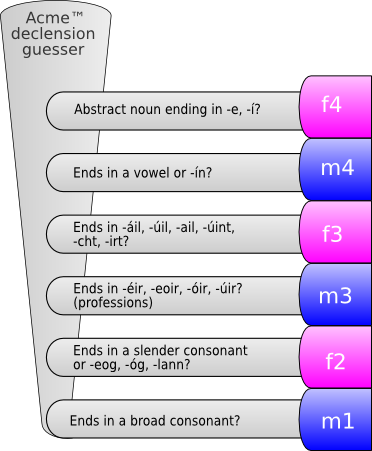What's a declension?
In Irish, a declension is basically a group of nouns that tend to form the plural and genitive according to a common pattern. (Declensions are more complex in some languages.)
Why do I care what declension a noun belongs to?
Knowing the declension can help you figure out the genitive and plural form of the noun.
What declensions are there?
The first declension is almost all male nouns. The second is mostly female. The third and fourth declensions have both male and female nouns. Technically, there are 5 declensions. However, the fifth declension is sort of miscellaneous, and it's full of common nouns you probably already know, so I think it's easier to ignore it.
How do I tell what declension a noun is?
Look at the common (nominative) form of the noun and ask yourself the questions in the diagram below. Be sure to stop at the first "yes" answer, because that's the declension that the noun probably belongs to.
Note: An abstract noun represents something that you can't see, touch, feel, taste or smell.

Examples
leabhar
- No, it's not an abstract noun.
- No, it doesn't end in a vowel or -ín.
- No, it doesn't end in -áil, -úil, -ail, -úint, -cht, or -irt.
- No, it doesn't end in -éir, -eoir, -óir, -úir.
- No, it doesn't end in a slender consonant or -eog, -óg, -lann.
- Yes, it does end in a broad consonant, so it's probably m1. A check of the dictionary tells us we're right.
fuinneog
- No, it's not an abstract noun.
- No, it doesn't end in a vowel or -ín.
- No, it doesn't end in -áil, -úil, -ail, -úint, -cht, or -irt.
- No, it doesn't end in -éir, -eoir, -óir, -úir.
- Yes, it ends in -eog, so it's probably f2. The dictionary agrees.
iontráil
- No, it's not an abstract noun.
- No, it doesn't end in a vowel or -ín.
- Yes, it end in -áil, so it's probably f3. The dictionary agrees.
páiste
- No, it's not an abstract noun.
- Yes, it ends in a vowel, so it's probably m4. The dictionary agrees.
airde
- Yes, it's an abstract noun (meaning "height"), so it's probably f4. The dictionary agrees.
Exceptions
There are exceptions, of course, so it is best to learn the declension when you learn the noun, or to check the dictionary. Here is one important exception to know: im and sliabh are m2 (most second-declension nouns are feminine, but these are masculine).
I know the declension, now what do I do?
Once you've figured out which declension a noun belongs to, a chart like the one below will help you remember how the noun declines. I recommend that you read a good explanation of noun declensions, while keeping this diagram handy.
There's a lot of information packed into this diagram, and it can be a bit overwhelming at first. In the beginning, just pay attention to the first one or two nouns in each declension; they represent the most common patterns.
Remember, for strong plural gpl = npl = vpl
|
|
ns | gs | vs | npl | gpl | vpl |
|---|---|---|---|---|---|---|
|
m1 ending in a broad consonant |
bád
fear béal íasc síol bacach taoiseach gaiscíoch |
báid
fír béil éisc síl bacaigh taoisigh gaiscigh |
= gs | = gs | = ns | Add -a to ns |
|
deireadh
saol |
deiridh
saoil |
deirí
saolta |
deirí | = npl | ||
|
f2 ending in a slender consonant, or -eog, -óg, -lann |
beach
bos scornach eaglais |
beiche
boise scornaí eaglaise |
= ns |
beacha
bosa scornacha eaglaisí |
= ns | = npl |
| aisling | = npl | |||||
| aislinge | aislingí | |||||
|
m3 ending in -aeir, -éir, -eoir, -óir, -úir |
cainteoir
gnólacht tincéir am |
bainteora
gnólachta tincéara ama |
= ns |
cainteorí
gnólachtaí tincéirí amanna |
= npl | = npl |
|
f3 ending in -áint, -úint, -irt >1 syllable ending in -cht |
adhmáil
beannacht ban-aba canúint droim |
admhála
beannachta ban-aba canúna drama |
= ns |
admhálacha
beannachtaí ban-abaí canúintí dromanna |
= npl | = npl |
|
m4 ending in -ín or a vowel |
bata
ciste cailín runaí rí bus |
= ns | = ns |
bataí
cistí cailíní runaithe rithe busanna |
= npl | = npl |
|
ordú
cruinniú |
orduithe
cruinnithe |
orduíthe
cruinnithe |
||||
|
f4 abstract nouns ending in -e or í |
bearna
féile |
= ns | = ns |
bearnaí
féilte |
= npl | = npl |

